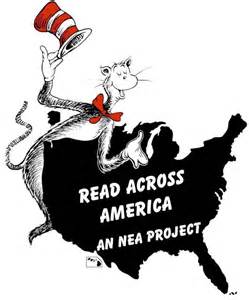Take part in the largest reading event in the United States on Friday, March 2! Gather books and readers for NEA’s Read Across America Day, celebrated on or around the birthday of Theodor Geisel, better known as Dr. Seuss. For background on the event and additional information, visit the ReadWriteThink.org calendar entry, and use the following resources to explore reading and celebrate Dr. Seuss with students:
Let’s Go on a Reading Hunt!
In this activity, children go on a hunt for places where they can read and enjoy books: on a family road trip, at the pool, at the doctor’s office. After exploring places to read, children compose their own books modeled on the rhythm and rhyme of Green Eggs and Ham by Dr. Seuss.
Using Picture Books to Teach Plot Development and Conflict Resolution
In this lesson, intermediate-level students explore the concepts of plot development and conflict resolution through focused experiences with picture books. The class searches the text and illustrations for cues to the development of the book’s plot and the resolution of the story’s conflict. They then use a graphic organizer to complete a structured analysis of plot and conflict resolution in the picture book. Finally, students have the opportunity to build bridges from their own experiences as readers to those skills needed as writers by revising their stories to strengthen the plot. This lesson includes an example conflict passage from Dr. Seuss’s The Lorax.
Id, Ego, and Superego in Dr. Seuss’s The Cat in the Hat
In this high school lesson, The Cat in the Hat is used as a primer to teach students how to analyze a literary work using the literary tools of plot, theme, characterization, and psychoanalytical criticism. Students then develop an argument stating the psychological personality for each character. They gather evidence supporting their arguments by identifying examples of indirect characterization in the text. Finally, students refine their analysis and develop an analytical essay.
From Dr. Seuss to Jonathan Swift: Exploring the History behind the Satire
Begin your class study of Jonathan Swift’s Gulliver’s Travels by reading Dr. Seuss’s The Butter Battle Book to illustrate the use of satire in a very accessible way. After reading the picture book, students discuss the historical allusions as a class. They are introduced to the concept of satire and identify the main satirical theme of the book.
How do you plan to celebrate Dr. Seuss and Read Across America?

